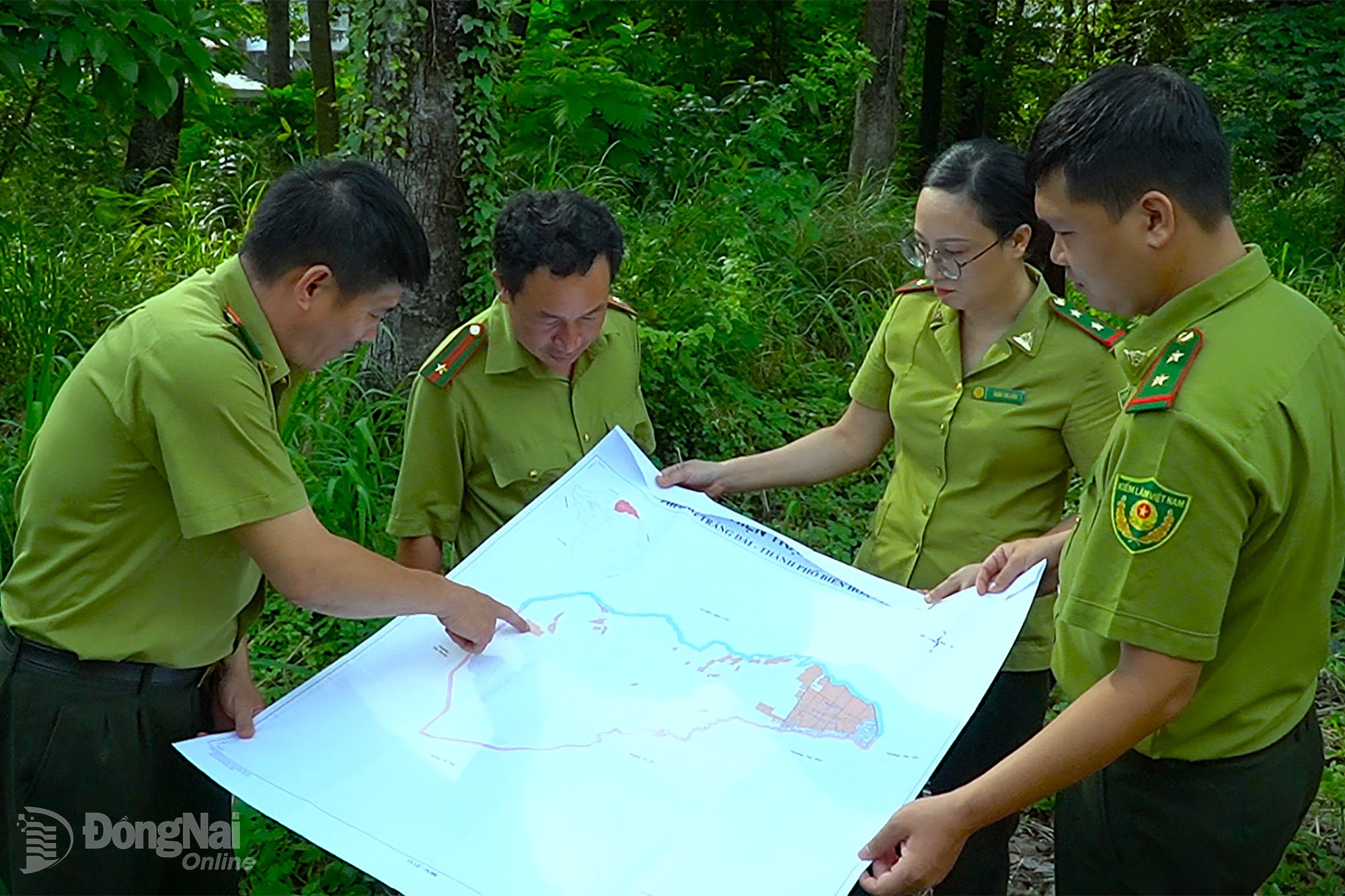However, the process of implementing and utilizing forest land still faces some difficulties and shortcomings that need to be promptly addressed so that the policy can continue to be effective in the future.
The contract-based policy is being put into practice.
According to Nguyen Le Anh Tuan, Director of the Tan Phu Protective Forest Management Board: Currently, the unit manages a total forest and forestry land area of over 18,000 hectares (more than 17,400 hectares of forested land and more than 634 hectares of non-forested land). The total area under contract is nearly 3,700 hectares/2,455 households, of which over 2,200 hectares/1,766 households (nearly 75%) have signed contracts, while more than 920 hectares/689 households (over 25%) have not yet signed contracts.
 |
| Officials from the Dong Nai Forest Protection Department are reviewing areas where forest land has been leased out. Photo: Thanh Nhan |
“Over the years, the policy of contracting out forest land has been implemented promptly and in accordance with regulations. This has created jobs and increased income for thousands of local workers. Most households receiving land under contract have complied well with regulations on forest management, protection, and development,” Mr. Le Anh Tuan shared.
Similarly, Deputy Director of Xuan Loc Protective Forest Management Board, To The Manh, stated: The Xuan Loc Protective Forest Management Board currently manages over 10,000 hectares of forest and forestry land. Of this, the unit directly uses and organizes production on nearly 1,843 hectares; collaborates in reforestation on nearly 1,392 hectares; and leases nearly 6,795 hectares to households and individuals for production through contract farming agreements.
Over the past period, the unit has strengthened the strict management of leased land areas, promptly handling issues arising during land use; and promptly and strictly dealing with violations to create a deterrent effect of the law. At the same time, it has created favorable conditions for people receiving leased land, especially poor households and families entitled to preferential policies, to invest in production and cultivate effectively.
A typical example is the household of Mr. Nguyen Van Dung, residing in Xuan Hoa commune. In 1986, Mr. Dung was assigned 10 hectares by the Xuan Loc Protective Forest Management Board (formerly Xuan Loc Forestry Enterprise) to invest in planting large timber trees and long-term crops. His family complied with the regulations regarding the assigned land according to the protective forest plan. Thanks to their shrewd business planning, combined with fertile land and favorable weather, their production model has yielded high economic efficiency, and their family's economy has steadily improved.
Solutions for the next phase
According to Tran Quoc Hung, Deputy Head of the Dong Nai Forest Protection Department: The land allocation program for forestry in Dong Nai province is implemented to manage, protect, and develop forests in a sustainable manner. Through this process, the province has gradually improved the management mechanism, expanded the area of land allocated to households, individuals, and communities, contributing to improved land use efficiency, increased forest cover, and improved livelihoods for people living near forests. The program also helps people gain more stable livelihoods through production forest planting, integrated forestry and agriculture , and legal exploitation of non-timber forest products.
To date, the implementation of the policy on allocating forest land has achieved many remarkable results; many areas of barren land and hills have been reforested, especially the situation of deforestation and forest fires has decreased significantly; the forest cover rate of the entire province has been maintained stably at 25.28%.
We will develop contract farming models linked to sustainable livelihoods, such as intercropping non-timber forest products, medicinal plants, and high-value native trees, so that people can directly benefit from the forest, contributing to the effectiveness and sustainability of the policy. We will encourage contracted households to cooperate and participate in ecotourism, resort, and recreational activities organized by forest owners to increase their income and stabilize their lives.
Deputy Head of Dong Nai Forest Protection Department Tran Quoc Hung
“People’s sense of responsibility for protecting and developing forests has been enhanced, forming a close relationship between people and forests. Many forest contracting models linked to integrated agricultural and forestry production have yielded economic benefits, contributing to stable livelihoods and reducing pressure on natural forests. This proves that the policy of contracting forest land is correct and brings practical benefits in terms of economics, society, and the environment,” said Mr. Tran Quoc Hung.
However, the policy of leasing forest land still faces difficulties and shortcomings such as: Some areas of leased land were initially production forests, but were later reclassified as protection forests, causing difficulties for the leaseholders in exploitation. Some leased land areas are far from people's residences but are not allowed to build temporary shelters for tools, causing difficulties for the leaseholders. The majority of leaseholders have low levels of education, so they often violate regulations. Post-leasing inspection and supervision in some forest management units are not carried out regularly…
In light of this situation, Dong Nai province has proposed several solutions for the future, such as: requiring people to sign and strictly adhere to forest management contracts; raising awareness of responsibility in protecting and developing forests; continuing to review and improve the land use plan for forestry; advising higher authorities to consider, amend, supplement, or provide detailed guidance on remaining issues in Decree No. 168/2016/ND-CP to suit local conditions; strictly handling cases of contract violations; and implementing the planting of large timber trees to improve the productivity, quality, and value of forests, aiming to participate in the forest carbon credit market under a sustainable development mechanism.
An Nhon
Source: https://baodongnai.com.vn/ban-doc/202510/go-kho-trong-giao-khoan-dat-lam-nghiep-07b2bca/


















































































































Comment (0)